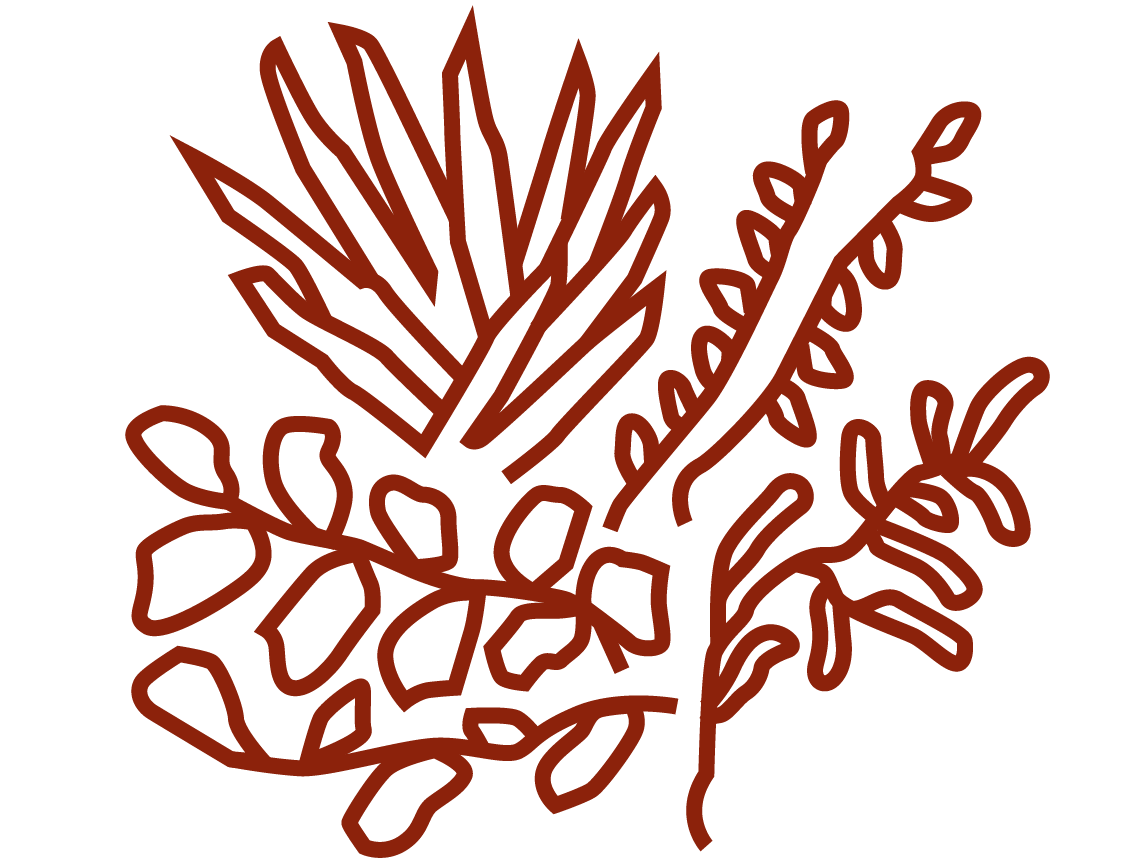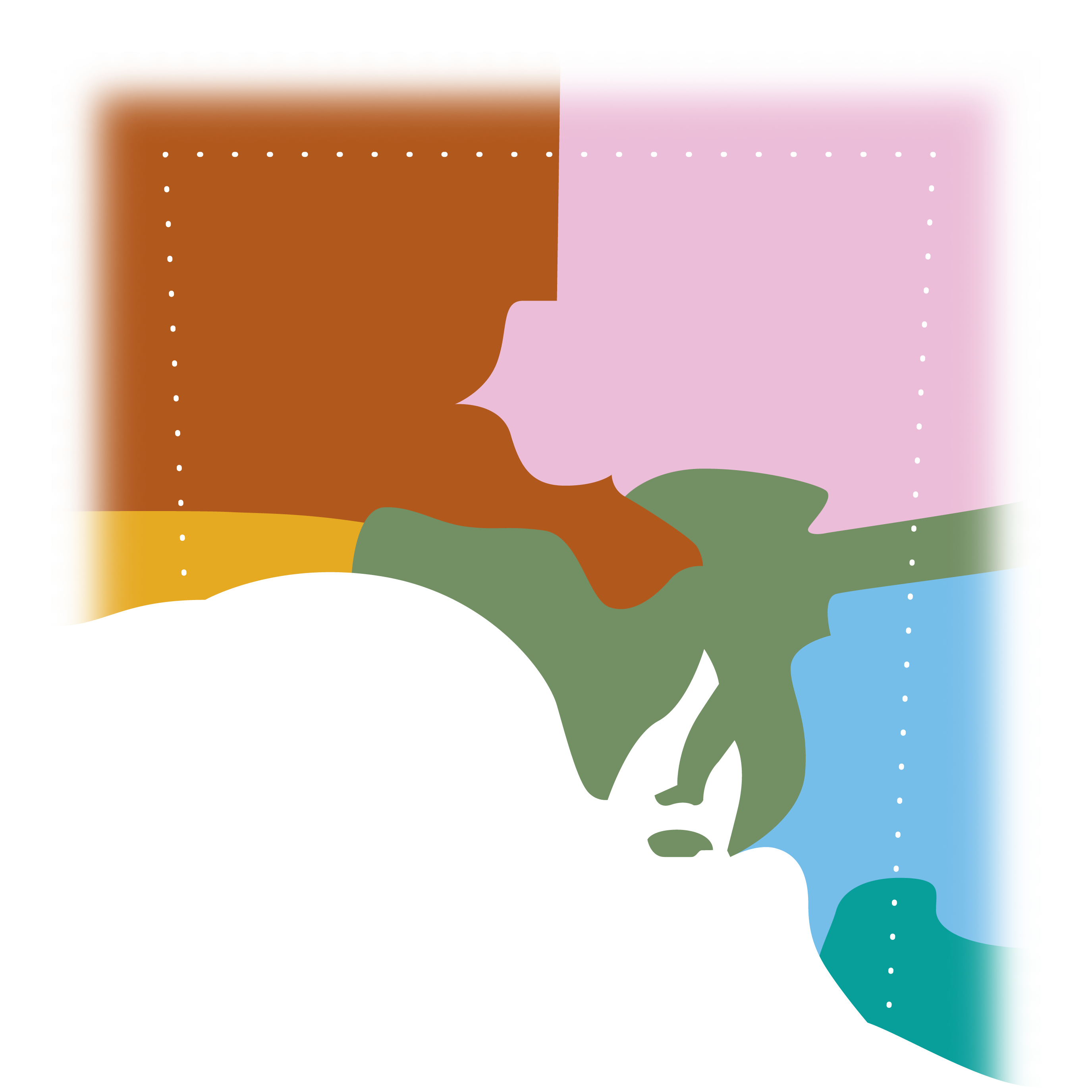
The Coorong region is home to a broad selection of native plants which can be used for food, medicine, or to make tools and other things which are useful for everyday life. Many of these plants have multiple purposes and have been used by the Tanganekald people for generations.
Edible plants
We will begin by looking at some edible plants of the Coorong.
| mantri | muntry |
The mantri fruit ripens in January and February and was traditionally collected by men, women and children. The mantri was made into cakes for storing and eating during the winter. These cakes were also used to trade for weapons and tool making stones, which were absent in the Coorong region. The mantri fruit were enjoyed with ngalakoi 'cockles'.
| tuldankari | glistening dock shrub |
The tuldankari is a shrub with purple flowers which was gathered and cooked in the wintjimi, a ground over. The thick young growths were steamed and eaten.
| kaneyang | kangaroo apple |
The kaneyang, or kangaroo apple, is a type of shrub related to a bush tomato which has delicious yellow fruit.
| parayi | honeysuckle |
The parayi is a Banksia, which is a valuable source of honey. Tanganekald women would gather the honey in August.
| kongi | bulrush |
The kongi was dug out of the mud lora 'swamps' by women and boys during August and September. The roots of this plant were dug up, cooked and eaten. The roots were sometimes eaten tumbi 'raw', and were so tough that it could take about an hour to eat one.
| milgi | pigface |
The milgi flowers in spring and summer. The fruit ripens when the flower is pollinated, turns a deep red colour and swells up. Dried milgi can be soaked in parenguki 'fresh water' to rehydrate and mashed with mullet to make a cake. The milgi also appears in a songline in which Ngurunderi, an ancestral being, is eating milgi on his travels from Middleton township to Cape Jervis. He carries milgi on his travels. He sits down on the cliffs opposite West Island to eat the last of his milgi. Because of this, some still grows there today and there is no milgi to be found further west.
| walakari | a kind of grass |
Walakari is a kind of grass which has edible seeds. It is gathered on the edges of salt marshes and on the Coorong sandhills.
| ngurli | native currant |
The ngurli is a shrub with pale green flowers. It produces a black, juicy fruit which ripens in September and October.
| kaintjari | spring yam |
Kaintjari are a type of yam which were gathered by women using kanaki 'digging sticks' from September to October. The kaintjari is very bitter when it's tumbi 'raw', but is delicious when cooked in ashes.
| tjelitjeli | bracken ferb |
The young stems and roots of the tjelitjeli were steamed in a wintjimi 'ground oven' and eaten.
| parangona | salt bush |
Seeds of the parangona were collected and cooked. The parangona is a ngaitji 'totem' of the Kangalindjeri clan.
| wuri | coastal wattle |
The wuri grows in sandy country. The women would collect the seed pods. They would run their fingernails inside the pods to release the seed. The seeds were pounded into a meal, mixed with water and steamed in a wintjimi 'ground oven'.
Medicinal plants
The Coorong has a large selection of bush medicine plants, and the whole country can heal you. Scroll down to learn about some Tanganekald plants and how they were used as bush medicines.
| kutuki | bitter quandong |
The kutuki was renowned for being a very strong medicinal plant. The patient would chew and swallow 2 or 3 mouthfuls of yelngok 'juice', which had a lokun 'bitter' taste. It could also be placed directly onto an open wound to heal it.
| maingguni | stinging nettle |
The maingguni was an important plant in the region. It was a common food source which was steamed, but also it was highly regarded as a medicine. It was used to treat toothaches. The Tanganekald people would sharpen a kangaroo bone, which was pushed it into the gum at the base of the sore tuwar 'tooth' to allow the bad blood to escape. Maingguni was briefly passed through a fire to burn the stinging hairs off, and it was then crushed. The yelngok 'juice' is held in the turi 'mouth' and moved over the tender spot. It was also used as a laxative. Maingguni was gathered along the water's edge in October and November.
| kutunggi | bastard quandong |
The kutunggi plant bears no fruit, however the roots were used as an aphrodisiac by the Yaraldi and Tanganekald men. The name of the medicine produced is known as parnimpari.
| talgi | thistle |
Talgi is a kind of herb that grows along the water's edge. Talgi was used as a method of contraception. Its contraceptive abilities were so strong that older women would advise younger women to consider using it carefully, as it was feared to make it hard for women to bear children later in life. Talgi was collected by women in August and September. It was eaten tumbi 'raw' and had a lokun 'bitter' taste.
| piyantuk | flax lily |
The piyantuk is a long grass. The reddish-brown roots of the piyantuk were boiled and consumed to treat colds.
| lowi | native mallow |
The lowi is a kind of shrub with purple flowers. It produces edible fruit. The leaves and stems were steamed and used as a paste for muscle and joint pain. Lowi was also a laxative. It was available all year.
| kurandjantarnd | broom bitter-pea |
The kurandjantarnd, also known as the spiny bitter-pea, is a dense small shrub with yellow-brown flowers which bloom in September and November. It was used to treat lung complaints.
Plants for making tools and other useful things
Deadly work! Now we are going to have a look at plants that were traditionally used to make tools and other useful things including blankets, glue, weapons, baskets, and more. For more information on the grasses used in weaving and basket, please see…
| tangari | edible gum of acacia |
Tangari is a gum produced by wattle trees. The tangari was mixed with lime sand to produce a glue. This glue was used to attach handles to knives, stone axes, and other tools.
| mowantji | native pine |
The mowantji wood is traditionally used for making spears and rafts. The mowantji appears in a songline with Ngurunderi's two wives. The wives used pine poles to spear fish and make canoes at a place called Mowanthang. They left a clump of mowantji behind, and now they are the only mowantji growing on that side of the peninsula.
| pelbi | golden wattle |
The pelbi produces edible seeds and a gum. The gum was used to produce a glue used in attaching flint flakes to spears for serious fighting.
| mulaweri | a waterseed |
Mulaweri is gathered in the lagoon shores. It was traditionally used in making fires with a lot of kari 'smoke'. The kari 'smoke' was useful in duck hunting, as it would drive ducks into nets.
| kuka | native flax |
Kuka is a grass like plant with blue flowers. It was used to make fishing lines and nets. An important place for locating kuka is at Kukaray 'Flax Point'.
| pitjangga | native cherry |
The pitjangga is a large shrub or small tree which produces red edible fruit. It was used in making a resin for attaching handles to tools.
| ngamurrunyi | a waterweed |
Ngamurrunyi is a type of waterweed that grows in the Coorong. The ngamurrunyi was used to make blankets. It was also a ngaitji of Milerum and the Tempuru mindjeri people.
| karelanggi | a waterweed |
The karelanggi can be found growing on stones. It is dried and rubbed with animal fat to make string. It is also the ngaitji of the Martardi people.
Other useful words related to plants and preparing food
Useful words to accompany sentences about food.
| yelngok | juice of any plant; sap | |
| keinpan | sweet taste | |
| lokun | bitter taste; salty taste | |
| puruwurupun | to spit out (e.g. a pith or roots after chewing to get juice) | |
| wintjimi | ground oven made of stone | |
| tumbi | raw; fresh; living |
Here are some sentences using these plant words.
| Tarti kaltun kaintjari-urambi. | Little sister is digging for spring yam. |
tarti means 'younger brother/younger sister', kaltun means 'digging', kaintjari means 'spring yam' and the ending -urambi means 'for'.
| Ngenta muraraman tjelitjeli? | Will you please tenderise the bracken fern? |
ngenta means 'you' , muraraman means 'will tenderise' and tjelitjeli means 'bracken fern'.
| Matjurunu puruwurupur kongi. | Father spat out the bulrush roots. |
Matjurunu means 'father', puruwurupur means 'spat out' (puruwurupun would mean 'spitting out') and kongi means 'bulrush'.
| Nangar ngungyun talayarrinyi wintjimi-urambi. | Mother is making a fire for the ground oven. |
Nangar means 'mother', ngungyun means 'to make (a fire)', talayarrinyi means 'fire', wintjimi means 'ground oven' and the ending -urambi means 'for'.
| Porli turtumbarun parayi-urambi. | The child is greedy for honeysuckle. |
porli means 'child', turtumbarun 'means to be greedy (for food)', parayi means 'honeysuckle' and the ending -urambi means 'for'.

